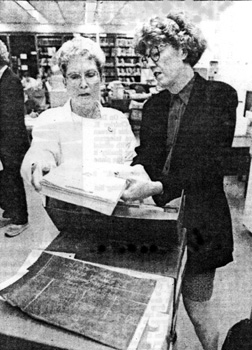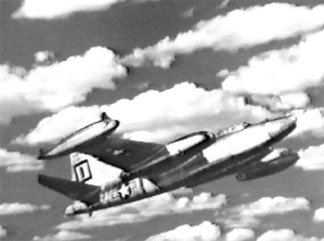Korean War RB-45C
|
||||||||||
|
Still, Moscow denies it ever had contact with the RB-45 crew. Mrs. Dear began digging. She attended congressional hearings in Washington and searched Air Force archives at Maxwell Air Force Base, Ala., and at the National Archives in Washington and Suitland, Md. She found Nancy Dean, who coincidentally had begun her own research from a basement “war room” in her Wheaton, Md., home. Mary Jo McDonough stayed in Glen Rose after her husband was listed as missing. She never changed houses, never married again. But she didn’t wait idly. She sought out her husband’s colleagues when they returend after the war. She wrote to families of other missing airmen and urged them to press for a full accounting. In a letter to President Eisenhower on Jan. 5, 1954, Mrs. McDonough wrote, “This matter is more important to me and the thousands in my position than anythings else. And we’re not going to forget it.” She got no answers. Than, thanks to her daughter’s persistence, an answer came in October 1993: McDonough died about two weeks after his plane was shot down. Not all details are known and the body has not been recovered. “My mother had been waiting for 40 years,” Mrs. Dear says. “For us it’s like a miracle” to know for sure he died, and to complete their grieving. Of the hundreds of relatives of Korean War MIAs, Mrs. Dear apparently is the first to have confirmed a death through her own research and a network of contacts in the United States and abroad. Ironically, the clinching evidence came not from U.S. government files but from Russia, whos MIG fighters shot down McDonough’s plane near the Yalu River that separates North Korea from China. McDonough parachuted from the plane. The one-page document which said McDonough had died was found in Russian archives by Paul Cole of the research firm Defense Forecasts Inc., who has extensively studied Soviet links to Korean War MIA cases. Mrs. Dear got a copy. It was dated Dec. 18, 1950 — exactly two weeks after the shootdown — but did not indicate the exact date or cause of death. Routing notations on the document indicate it circulated at the highest levels of the Soviet military staff in Moscow. “I am informing you that the pilot from the shot-down RB-45 aircraft died en route and the interrogation was not finished,” said the note in Russian. It was signed by Marshal Stepan Krasovskii, the senior Soviet military adviser to China, and addressed to Marshal Pavel Batitskii, chief of the General Staff in Moscow. This fits with recollections of the only American known to have talked to McDonough after he was shot down. Retired Air Force pilot Hamilton B. Shawe, Jr., of Reno, Nev., said he spent about three days with McDonough as a POW in a bombed-out prison in Sinuiju, in northern Korea, starting about Dec. 14. |
||||||||||
|
He says he last saw MCDonough being taken away from the prison on an ox cart, and that he was in such bad condition that it seemed unlikely he could live much longer.
Shawe said McDonough told him he had parachuted from the burning wreckage of the RB-45. He later suffered severe frostbite while trying to evade capture in the frozen wilds. When he sought food at an isolated Korean house, the occupants turned him in to the military. The exact time sequence is unclear. Shawe reported his contact with McDonough to the Air Force in 1953 when he was released from captivity. On the basis of this information, and the lack of other news, the Air Force issued a presumptive finding of death on March 1, 1954. Although the McDonough family members accept the Russian document as evidence that he died, they realize it raises other questions. Where were they taking him when he died? What did the Soviets want from him? What was done with the body? |
 |
|||||||||
|
|
||||||||||
| A second Russian document obtained by Cole this year makes the Soviet link even clearer. It says the RB-45 was shot down about 45 miles east of Andung, China, just across the border from Sinuiju, North Korea. The report summarizes what McDonough said under a Soviet-controlled interrogation and asks that Russian “advisers” in Korea help retrieve downed American aircraft. |
||||||||||
| This document was dated Dec. 17, 1950, and was signed by the Soviet commander of the 64th Fighter Aviation Corps, which headed Soviet air operations in Korea.
In November 1994, Mrs. Dear learned more painful details through a confidential source who interviewed the MiG Pilot, A.F. Andrianov, who is credited with shooting down the RB-45. Andrianov recalled being told by the Soviet officer who interrogated McDonough that while McDonough was being moved from Sinuiju, apparently on Dec. 18, a sign was hung on him, “U.S. War Criminal.” |
||||||||||
 |
||||||||||
|
Ctsy. Howard Myers |
||||||||||
|
Home - Contact Us - Cold War Hist. - 91st SRS Hist. - Stardust 40 Mission Story |
||||||||||